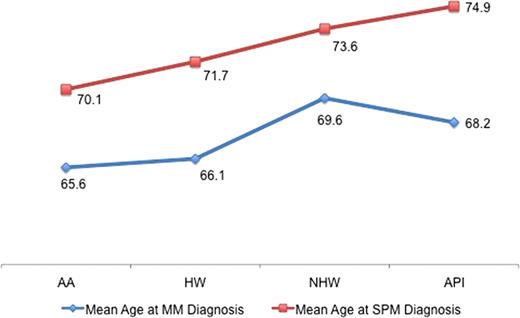Abstract
Abstract 678
Second primary malignancies (SPM) among multiple myeloma (MM) patients have been reported with an estimated incidence varying from 1%–15%. We have previously reported that significant disparity exists in MM survival across patients of different ethnicities. We undertook a Surveillance Epidemiology and End Results (SEER) based analysis to describe the incidence of SPM among MM patients of different ethnicities, in order to explore the variable impact that SPM might have on MM outcomes of patients across racial subgroups.
SEER database was used to examine the standardized incidence rates (SIR) of SPM among MM patients diagnosed between 1973–2008. Observed to expected ratio (O/E) of SPM was calculated using incidence rates of cancers for the general population. The 95% confidence limits (CI) were constructed using Fisher's exact test. The analysis was restricted to patients with MM as first primary, microscopic confirmation of diagnosis, reporting sources not coded as autopsy- or death-certificate-only, and SPM reported more than 2 month after MM diagnosis. Mutually exclusive race/ethnicity categories were: African-Americans (AA), Asians/Pacific Islanders (API), Hispanic whites (HW), Non-Hispanic whites (NHW), and others. The risk of SPM among MM patients was explored by ethnicity, type of SPM, and latency period.
A total of 3090 cases of MM with SPM were diagnosed between 1973–2008, of which, 2021 patients met our inclusion criteria. Stratification of SPM by ethnicity revealed: 387 AA (19%), 72 API (4%), 51 HW (3%), 1500 NHW (74%) and 11 other (<1%) cases. There was an average 4.7-year latency period between diagnosis of MM and SPM (mean age 68.2 and 72.9 years, respectively). The latency period was not significantly different by type of SPM (solid organ vs. hematological) or ethnicity. AA had the youngest age at diagnosis for both, MM and SPM (65.6 and 70.1 year, respectively). (Figure 1) For all SPM sites analyzed together, there was no significant difference between the observed and expected incidence (O/E 0.98; 95% CI 0.94–1.02). However, O/E risk was significantly decreased for solid organ SPM (N=1695; O/E 0.92; 95% CI 0.88–0.96) and increased for hematological malignancies (N=263; O/E 1.63; 95% CI 1.44–1.84). Highest excess risk among all SPM was noted for acute non-lymphocytic leukemia (ANLL) (O/E 6.51; 95% CI 5.37–7.83). The overall risk of observed SPM was not different from expected rates by ethnicity, with the exception of HW who had a significantly decreased overall SPM risk. Table 1 summarizes significant results of O/E risk of SPM by race and site. HW and NHW were less likely to develop overall solid organ SPM. Within solid organ sites, HW had a significantly decreased O/E risk of developing lung/bronchus and prostate SPM. NHW were the only ethnic subgroup with an increased O/E risk of developing melanoma of skin, while the O/E risk of developing SPM of kidney/renal pelvis was increased only among AA. The risk of ANLL as SPM was significantly increased among AA, API, and NHW, while risk of NHL as SPM was only increased among NHW.
Mean age at diagnosis of MM and SPM among various ethnic subgroups.
Mean age at diagnosis of MM and SPM among various ethnic subgroups.
Sites with significant difference in observed and expected risk of SPM for different race/ethnic subgroups.
| Race . | SPM Type . | Risk . | O/E Risk HR . | 95% CI . |
|---|---|---|---|---|
| Hispanic whites (HW) | Overall | Decreased | 0.67 | 0.50–0.88 |
| All solid-organ | Decreased | 0.66 | 0.48–0.89 | |
| Lung/bronchus | Decreased | 0.34 | 0.08–0.88 | |
| Prostate | Decreased | 0.48 | 0.19–0.99 | |
| Non-Hispanic whites (NHW) | All solid-organ | Decreased | 0.90 | 0.85–0.95 |
| Melanoma of skin | Increased | 1.38 | 1.06–1.78 | |
| ANLL* | Increased | 6.85 | 5.55–8.38 | |
| NHLà | Increased | 1.28 | 1.01–1.61 | |
| African American (AA) | Kidney/renal pelvis | Increased | 2.17 | 1.31–3.39 |
| ANLL | Increased | 6.24 | 3.41–10.47 | |
| Asians/Pacific Islanders (API) | ANLL | Increased | 6.32 | 1.72–16.19 |
| Race . | SPM Type . | Risk . | O/E Risk HR . | 95% CI . |
|---|---|---|---|---|
| Hispanic whites (HW) | Overall | Decreased | 0.67 | 0.50–0.88 |
| All solid-organ | Decreased | 0.66 | 0.48–0.89 | |
| Lung/bronchus | Decreased | 0.34 | 0.08–0.88 | |
| Prostate | Decreased | 0.48 | 0.19–0.99 | |
| Non-Hispanic whites (NHW) | All solid-organ | Decreased | 0.90 | 0.85–0.95 |
| Melanoma of skin | Increased | 1.38 | 1.06–1.78 | |
| ANLL* | Increased | 6.85 | 5.55–8.38 | |
| NHLà | Increased | 1.28 | 1.01–1.61 | |
| African American (AA) | Kidney/renal pelvis | Increased | 2.17 | 1.31–3.39 |
| ANLL | Increased | 6.24 | 3.41–10.47 | |
| Asians/Pacific Islanders (API) | ANLL | Increased | 6.32 | 1.72–16.19 |
ANLL=Acute Non-Lymphocytic Leukemia, àNHL=Non Hodgkin Lymphoma
Exploring potential causes of outcome disparities is important for evaluating disease characteristics and optimal triaging of healthcare resources for specific patient populations. We have performed the largest population-based analysis for the risk of SPM in MM patients stratified by race/ethnicity. We found that the risk of developing SPM among MM patients is variable depending on the patient's ethnic background. This warrants further exploration of the impact of SPM on outcomes of MM patients across different racial subgroups.
No relevant conflicts of interest to declare.
Author notes
Asterisk with author names denotes non-ASH members.


This feature is available to Subscribers Only
Sign In or Create an Account Close Modal